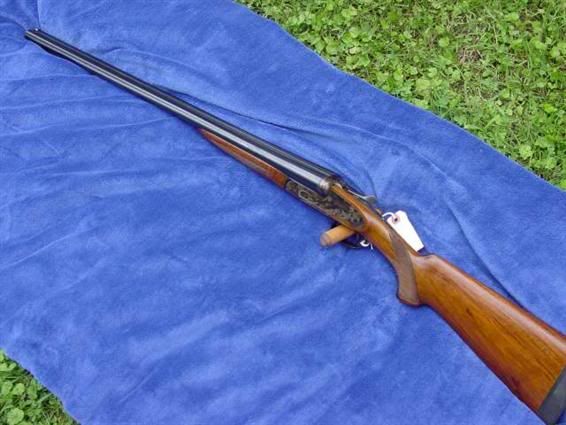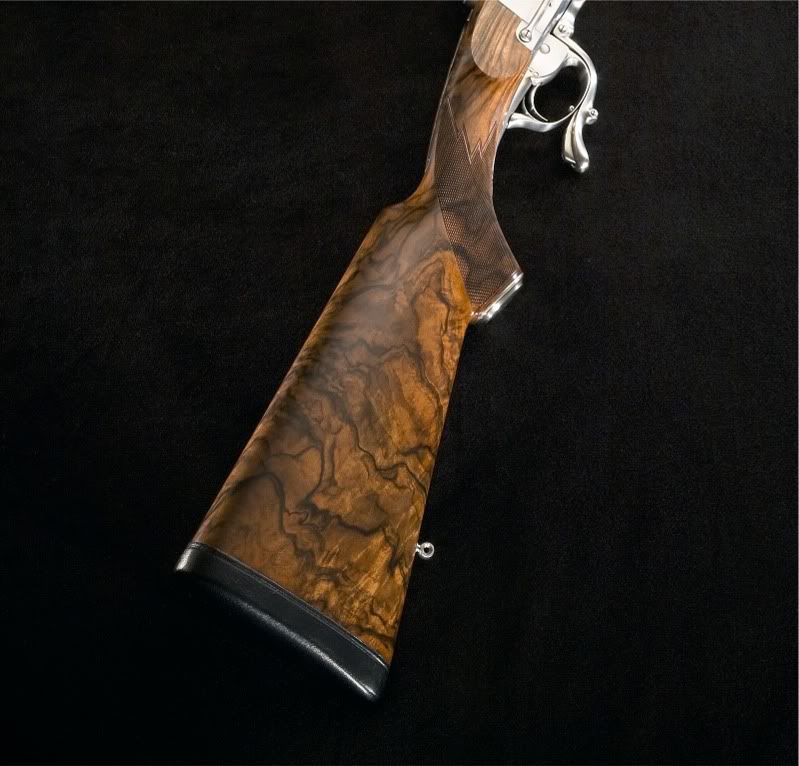|
S |
M |
T |
W |
T |
F |
S |
|
|
|
|
1
|
2
|
3
|
4
|
|
5
|
6
|
7
|
8
|
9
|
10
|
11
|
|
12
|
13
|
14
|
15
|
16
|
17
|
18
|
|
19
|
20
|
21
|
22
|
23
|
24
|
25
|
|
26
|
27
|
28
|
29
|
30
|
31
|
|
|
|
Forums10
Topics38,500
Posts545,471
Members14,414
| |
Most Online1,344
Apr 29th, 2024
|
|
|
|
Joined: Feb 2002
Posts: 1,559 Likes: 22
Sidelock
|
OP

Sidelock
Joined: Feb 2002
Posts: 1,559 Likes: 22 |
Made a trip to a local gunstock blank provider located in Virginia yesterday just to see what he had. He supplies mostly to the flintlock long rifle crowd with loads (i.e. 1,000's of blanks) of curly maple. He does however have quite a bit of local black walnut as he purchases tree's from Iowa to NC to Pa. Anyway, when I called him I was inquiring about whether he might have a bit of English available and he said yes and I made the trip.
What I uncovered is all of the English he has is harvested locally for the most part. All cut from various old estates in the area (Middleburg for example). He said English walnut while fairly rare to find in the east is still here. He also said that while he has pretty highly figured wood (very nice curl for example), it doesn't have the dark streaks which English has in other parts of the country (California for example).
My question is if they are all pretty much the same species, why no dark streaking here? Is the big difference the type of soil here as compared to out west?
He actually had a fair amount of english, all dense with small pores with lots of it quartersawn (my personal favorite). Looking through loads of it yesterday, the only thing I think it lacks is indeed the mineral streaks.
Also, as part of my education process, I've noticed that quite a few of the Ruger Number one's were made with Circassian (fancy name for English) walnut under the Boddington African series. I've seen a fair number of those at gunshows and such and none I've seen have the marbling/dark streaks that appear to me. They all however seem to be laid out correctly and be pretty dense.
Appreciate any pictures that might be available. FWIW, I have read Pete's H's Walnut primer, but would appreciate any other thoughts. If any one wants to know who the local merchant was, please drop me a PM.
PS. Just as a note, this fellow cuts his wood in 3" thick pretty much huge sections. Everything is stickered and stored in warehouses for at least two years and then it goes into his kiln. The ends of everything I saw was sealed as was any crotch areas.
foxes rule
|
|
|
|
|
Joined: Apr 2007
Posts: 110
Sidelock
|

Sidelock
Joined: Apr 2007
Posts: 110 |
tut:
I am sure from your description the gentleman is the same guy who displays at the Baltimore show each spring. I have seen his English walnut; its appearance is basically the same as the few trees I have cut here in PA: fairly light in color, somewhat open-pored, little contrasting streaking/marbling. It will, however, make up into a very nice stock, although you may wish to dye the wood a bit.
In answer to your question, (not being a horticultural person) I would think you are correct in that the soil content is what makes the difference. Seeing as how all thin-shelled walnut that is used for gunstocks (Circassian, Frenceh, Turkish, English) is the same species of tree, where it's grown and the conditions the tree endures seem to be the deciding factor. This is a point of interest to me, too, so any information from knowledegable people would be welcome.
Craig Libhart
|
|
|
|
|
Joined: Feb 2004
Posts: 13,880 Likes: 15
Sidelock
|

Sidelock
Joined: Feb 2004
Posts: 13,880 Likes: 15 |
I'm no expert, but all that I've read on it indicates they are all the same species and the climate and soil are the keys to the color and mineral lines.
|
|
|
|
|
Joined: Jan 2002
Posts: 5,954 Likes: 12
Sidelock
|

Sidelock
Joined: Jan 2002
Posts: 5,954 Likes: 12 |
Making "mineral streaks" via inking is a farily mature art form. We have no qualms over staining wood. We accept engraving and coloring steel as natural. Why the stigma over inking a plain candidate stock to improve its appearance?
The modern gun may include CAD design, CAM machined parts, high alloy steels, non-ferrus alloys, plated metal, laser engraving, poly wood finish, etc. So, why get any heart burn over inking wood?
Few can order a best gun. Most can buy/build a beautiful gun. Wallet determines how much of the beauty is completely natural and how much requires some "assistance."
|
|
|
|
|
Joined: Jan 2002
Posts: 7,703 Likes: 103
Sidelock
|

Sidelock
Joined: Jan 2002
Posts: 7,703 Likes: 103 |
I completely agree with rocketman on this one. We have one of the best grain enhancers in the business on this forum. I have a pretty nice Uggie sidelock with extremely plain wood; when I get around to it I plan to see if I can afford some of Mark Larson's artistic talent for a stock re-do...Geo 
|
|
|
|
|
Joined: Jan 2002
Posts: 1,737
Sidelock
|

Sidelock
Joined: Jan 2002
Posts: 1,737 |
Where does one catgegorize that West Coast specialty, Claro Walnut? This wood has its own very unique streaking, unlike any of the other walnuts I've seen.
When I first encountered this wood years ago I was predictably "wowed". However, somewhere along the way I tired of seeing guns stocked with it. It sounds crazy, but it seems to me to have too much "flash" without the staying power of the marble and smoke "traditional" walnut.
I think that's become the story for me in regards to Turkish walnut as well.
Anyone think I'm completely nuts on this?
|
|
|
|
|
Joined: May 2005
Posts: 482
Sidelock
|

Sidelock
Joined: May 2005
Posts: 482 |
Are there not varietals within what we call "english" walnut bred to grow faster to reach nut-producing age sooner? I believe I've heard this from several people that at least seem to know what they are talking about. Macintosh and granny Smith are both "Apple", I'm lead to believe Walnut is similar. I'd think local climate, soil type, amount of moisture, etc would have a profound effect, but also if there truly are varietals then that may also have some noticable effect. Here's at least one link detailing some of the varieties...I have heard that Franquette makes good stock wood, and have heard of some of the others, but don't really know much about them. I believe most are Juglans Regia though. walnut cultivars
Last edited by David Furman; 07/09/11 10:11 AM.
|
|
|
|
|
Joined: May 2010
Posts: 1,529 Likes: 80
Sidelock
|

Sidelock
Joined: May 2010
Posts: 1,529 Likes: 80 |
Please dont be confused ,several old writers used the term "English Walnut" to imply the walnut wood used on English guns .Not necessarily English grow wood. Although I have seen some very pretty English grown walnut with pinks and blacks in the grain , our climate tends to give native grown wood a lot of shakes that tend to show up when the wood is seasoned.Great for furniture . I do know of several people that have tried to use home grown wood ,but with limited success . The last thing any stocker wants is to supply wood that is likely to come back on him so most wont use it unless the customer supplies it and accepts the risks.
|
|
|
|
|
Joined: Jan 2002
Posts: 749 Likes: 16
Sidelock
|

Sidelock
Joined: Jan 2002
Posts: 749 Likes: 16 |
tut:
I am sure from your description the gentleman is the same guy who displays at the Baltimore show each spring. I have seen his English walnut; its appearance is basically the same as the few trees I have cut here in PA: fairly light in color, somewhat open-pored, little contrasting streaking/marbling. It will, however, make up into a very nice stock, although you may wish to dye the wood a bit.
In answer to your question, (not being a horticultural person) I would think you are correct in that the soil content is what makes the difference. Seeing as how all thin-shelled walnut that is used for gunstocks (Circassian, Frenceh, Turkish, English) is the same species of tree, where it's grown and the conditions the tree endures seem to be the deciding factor. This is a point of interest to me, too, so any information from knowledegable people would be welcome.
Craig Libhart Tut, I pretty much agree with Craig's analysis in that eastern grown "English" for better words doesn't have the growing conditions that give it the mineral streaks etc. I cut a "English" walnut in Pennsylvania a number of years ago that had very little mineral streaking in it. although it had very nice grain or fiber flow. The Juglans Regia from California etc is an different matter, as shown by the two blanks below.   Here is a photo of some Turkish that I worked with a while back. It looks entirely different than California wood. This wood was not my "cup of tea" but it looks fine on a Perazzi target gun.  Then we have this piece of Turkish that looks very nice on a Gibbs. 
Doug Mann
|
|
|
|
|
Joined: Feb 2002
Posts: 1,559 Likes: 22
Sidelock
|
OP

Sidelock
Joined: Feb 2002
Posts: 1,559 Likes: 22 |
Interesting, when I was talking to this fellow I asked him what kind of wood this particular English tree had in the root ball area. He replied he can't dig out the root balls in this area because of the rocks involved. He said out west the soil for the most part doesn't have this kind of rock and thus it was quite easy to dig out the root ball and get some really special wood. He cuts all of his tree's at ground level.
FWIW, he said the English tree that provided the wood I was looking at was well over 150 years old. 8 feet across at the base. Now, that's a helluva tree anywhere.
PS. Doug that would be some real nice wood your displaying. Would like to have a big truck and head out west to a bunch of walnut suppliers and buy a truckload and promptly let it age about ten years. Sounds like a pretty neat retirement plan.
foxes rule
|
|
|
|
|